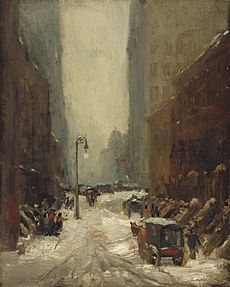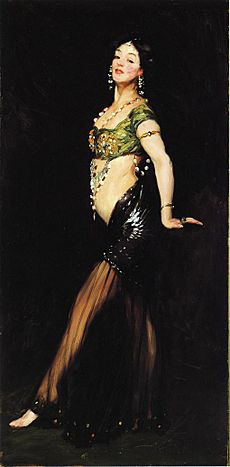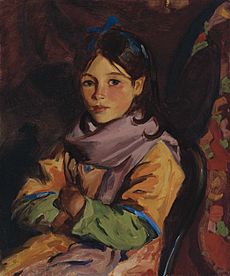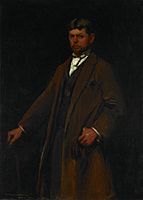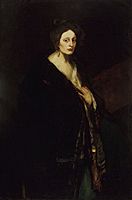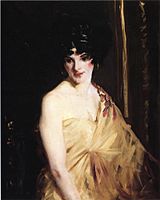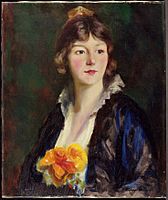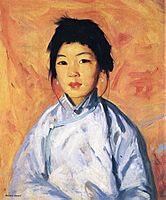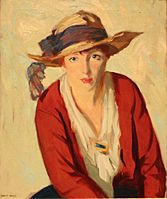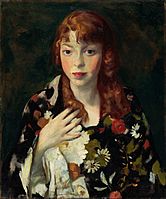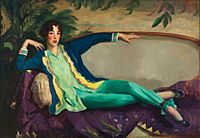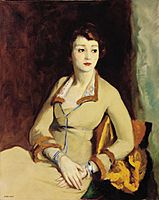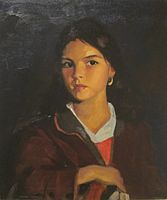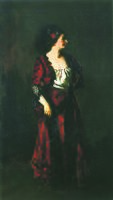Robert Henri facts for kids
Quick facts for kids
Robert Henri
|
|
|---|---|
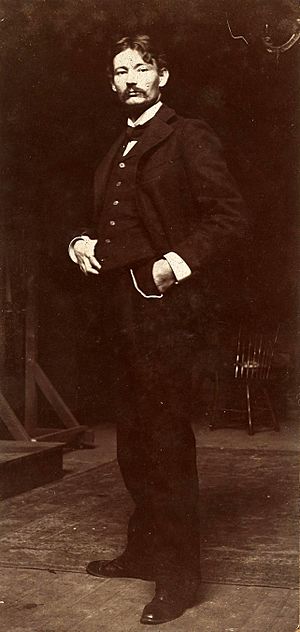
Robert Henri, 1897
|
|
| Born |
Robert Henry Cozad
June 24, 1865 |
| Died | July 12, 1929 (aged 64) New York City, New York
|
| Nationality | American |
| Education | Pennsylvania Academy of the Fine Arts, Académie Julian, École des Beaux Arts |
| Known for | Painting |
| Movement | Ashcan School |
Robert Henri (born Robert Henry Cozad) was an important American painter and teacher. He lived from 1865 to 1929.
When he was young, Henri studied art in Paris, France. He was inspired by the Impressionist painters and wanted to create a new, more exciting style of American art. He helped start the Ashcan School of American realism. This art movement showed everyday city life in a bold and direct way.
Even when new art styles like Cubism became popular, Henri still supported new and modern artists. He was named one of the top three living American artists by the Arts Council of New York.
Contents
Early Life and Family
Robert Henri was born in Cincinnati, Ohio. His parents were Theresa Gatewood Cozad and John Jackson Cozad. His father was involved in real estate. Robert Henri was also a distant cousin of the famous painter Mary Cassatt.
In 1871, Henri's father started a town called Cozaddale, Ohio. A few years later, in 1873, the family moved west to Nebraska, where his father founded another town named Cozad.
In 1882, Henri's father had a serious argument with a rancher. After this event, the family decided to change their names to avoid problems. Robert's father became Richard Henry Lee, and Robert became Robert Earl Henri. In 1883, the family moved to New York City, and then to Atlantic City, New Jersey, where Robert began painting.
Art Education
In 1886, Henri started studying at the Pennsylvania Academy of the Fine Arts in Philadelphia. He learned from teachers like Thomas Pollock Anshutz and Thomas Hovenden.
In 1888, he traveled to Paris, France, to study at the Académie Julian. There, he admired the work of Francois Millet and became interested in Impressionism. He also got into the École des Beaux Arts. During this time, he visited different parts of France and Italy.
By 1891, he returned to Philadelphia and continued his studies. In 1892, he began teaching at the Philadelphia School of Design for Women. He was a very good teacher and quickly became popular with his students.
His Art and Work
In Philadelphia, Robert Henri started a group of artists who met in his studio. They talked about art and culture. This group included illustrators for the Philadelphia Press who later became known as the "Philadelphia Four": William Glackens, George Luks, Everett Shinn, and John Sloan. They called their group the Charcoal Club. They drew from life, socialized, and discussed ideas from famous writers and thinkers.
The Ashcan School
By 1895, Henri changed his mind about Impressionism. He felt it was becoming too traditional. He encouraged his friends and students to create a new, more real kind of art. He believed American painters should show the modern American city, including its less fancy parts.
The paintings by Henri and his friends, which showed this new way of looking at the world, became known as the Ashcan School. They didn't like academic painting or Impressionism, which they felt only showed the surface of things. Ashcan painters became well-known around the same time that realistic books and investigative journalism were becoming popular.
For several years, Henri split his time between Philadelphia and Paris. In Paris, he met a Canadian artist named James Wilson Morrice. Morrice taught Henri a quick way to paint small pictures called pochades on tiny wood panels. These panels could fit in a pocket with a small set of brushes. This method helped Henri paint city scenes quickly and spontaneously, which became a key part of his style.
In 1898, Henri married Linda Craige, one of his art students. They spent two years in France. In 1899, one of his paintings, La Neige ("The Snow"), was bought by the French government for a museum.
Henri taught at the Veltin School for Girls starting in 1900 and at the New York School of Art from 1902. Some of his famous students included Edward Hopper, Rockwell Kent, and George Bellows. In 1905, Linda died. Three years later, Henri married Marjorie Organ, a cartoonist. His 1911 painting of Marjorie, The Masquerade Dress, is one of his most famous works.
In 1906, Henri was chosen to be part of the National Academy of Design. But when his friends' paintings were rejected from an exhibition in 1907, he quit the jury. He decided to organize his own art show instead. He called the academy "a cemetery of art."
The Eight Artists
In 1908, Henri helped organize an important art show called "The Eight" at the Macbeth Galleries in New York. This show featured his own paintings and those of the "Philadelphia Four" (who had moved to New York). It also included three other artists with different styles: Maurice Prendergast, Ernest Lawson, and Arthur B. Davies. The exhibition was a protest against the strict rules of the National Academy of Design. The show traveled to many cities, sparking discussions about new art and what could be shown in paintings.
Henri was a leader in the group that wanted to show city life in a raw and lively way. This often shocked people who preferred more traditional art.
In 1910, Henri, with help from John Sloan and Walt Kuhn, organized the Exhibition of Independent Artists. This was the first art show in the U.S. where anyone could show their art without a jury or prizes. Paintings were hung in alphabetical order to show that all artists were equal. The exhibition was popular but didn't sell many paintings.
The Armory Show in 1913 was America's first big look at modern European art. Henri showed five paintings there. As an artist who painted real-life scenes, he knew that new styles like Cubism were a challenge to his own art. Some people thought his style was becoming old-fashioned. However, Henri was still interested in new art and encouraged his students to study it. He even told his students to see works by Henri Matisse and Max Weber.
Henri was also interested in political ideas. He admired Emma Goldman, who published a magazine called Mother Earth. He taught at the Modern School starting in 1911. Goldman described him as "an anarchist in his conception of art and its relation to life."
Painting in Ireland and Santa Fe
Robert Henri made several trips to the west coast of Ireland. In 1913, he rented a house near Dooagh, a small village on Achill Island. Every spring and summer for many years, he painted the children of Dooagh. His portraits of children were very popular at the time and sold well. In 1924, he bought the house in Ireland.
During the summers of 1916, 1917, and 1922, Henri also visited Santa Fe, New Mexico, to paint. He found this place as inspiring as Ireland. He became an important part of the Santa Fe art scene. He convinced the director of the state art museum to allow all artists to exhibit their work. He also encouraged other artists like George Bellows and John Sloan to come to Santa Fe.
Later Life and Death
In November 1928, while traveling back to the United States from Ireland, Robert Henri became ill. He had prostate cancer, which weakened him. He died in New York City on July 12, 1929, at the age of 64. His illness was not widely known, so his death surprised many in the art world.
After he died, his student Eugene Speicher said that Henri was not only a great painter but also "the father of independent painting in this country." His ashes were buried in his family's vault in Philadelphia.
Influence and Legacy
From 1915 to 1927, Henri was a very popular and important teacher at the Art Students League of New York. He didn't just teach his students a style; he taught them an attitude and a way to approach art. He also gave talks about art theories.
Henri's ideas about art were collected by a former student, Margery Ryerson, and published in a book called The Art Spirit (1923). This book was popular for many decades. Some of his other famous students included George Bellows, Edward Hopper, Rockwell Kent, and John Sloan.
Henri was also a very important mentor for women artists. His female students helped shape American modern art. They created many artworks, exhibited widely, won awards, and taught art classes across America.
In the spring of 1929, just before he died, Robert Henri was named one of the top three living American artists. After his death, the Metropolitan Museum of Art held a special exhibition of 78 of his paintings to honor him. Forbes Watson, an art magazine editor, wrote that Henri was "an epoch-making man in the development of American art."
Some of Henri's most lasting works are his portraits of other painters. His portraits of George Luks (1904) and John Sloan (1904) show his classic style: strong brushstrokes, deep colors, and a way of capturing the person's spirit.
The Robert Henri Museum in Cozad, Nebraska, is in one of his former homes and focuses on his artwork.
The National Arts Club in New York City has the Robert Henri Library. It includes his artwork and scrapbooks. This library is open to scholars and professionals.
Gallery
-
Portrait of Carl Gustav Waldeck, 1896, Saint Louis Art Museum
-
Woman in Manteau, 1898, Brooklyn Museum
-
The Blue Kimono, 1909, New Orleans Museum of Art
-
Tam Gan, 1914, Albright-Knox Art Gallery
-
The Beach Hat, 1914, oil on canvas, The Detroit Institute of Arts
-
Edna Smith in a Japanese Wrap, 1915, Indianapolis Museum of Art
-
Portrait of Fay Bainter, 1918
See also
 In Spanish: Robert Henri para niños
In Spanish: Robert Henri para niños


